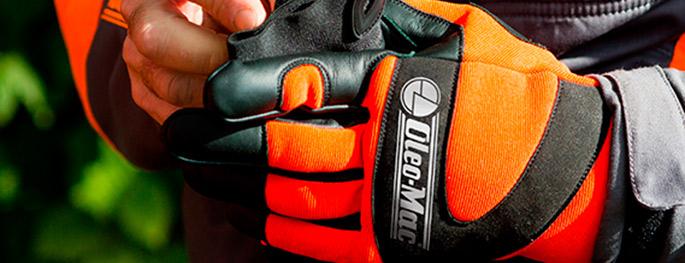How to eliminate pests and weeds with a backpack mistblower

For ornamental plants and vegetables, as well as fruit trees and crops in the fields, parasites are a menace throughout the year, albeit less aggressive and numerous during the winter months.
With a backpack mistblower you can apply pesticide treatments—namely fungicides, insecticides, acaricides etc. —as well as other chemical spray treatments, such as weed killers or plant growth regulating products.
If you need to apply pesticides and other treatments to plants in small-sized plots or places that are inaccessible to wheeled vehicles, there is no more practical solution than a backpack mistblower. In this article we explain how to use a mistblower—in the garden, vegetable plot, orchard or fields—for pest control or to apply other treatments useful to plants.
How to use a backpack mistblower for pest control and other treatments
The treatment liquid stored in the tank of the backpack mistblower is turned into droplets by a diffuser. These droplets are propelled out of the nozzle in an air jet created by an impeller and can cover great distances before settling on vegetation.
Oleo-Mac offers two professional backpack mistblower models: the MB 800 and the new MB 900 with 2-stroke petrol engine, The models have respective power ratings of 3.7 and 3.6 kW and a tank capacity of 14 and 17 l. In addition to liquid treatments, you can use a mistblower to spray plants with powder or granular products: simply fit the special dusting kit.
How can you use a mistblower to eliminate pests in the garden or to spread insecticide or fungicide in an orchard? Besides choosing the right product and dosage, the effectiveness of such treatments depends on the mistblower's liquid delivery rate, air flow and diffuser. So, it is important to adjust the mistblower to ensure correct micronisation of the treatment liquid:
-
Calibrate the liquid flow by turning the diffuser flow regulator: the greater the quantity, the larger the droplets.
-
Adjust the engine speed using the throttle trigger to calibrate the air flow: the higher the speed (and therefore the higher the volume of air blown), the smaller the droplets. Once you have determined the ideal speed, to maintain the setting and find it quickly on the MB 800 model, you can use the throttle limiter.
With the professional MB 900 backpack mistblower, at maximum engine rpm you can vary the horizontal delivery rate from 0.1 to 3.5 l/min. By contrast, the MB 800 gives you a liquid delivery rate of between 0.5 and 3 l/min. For targeted treatments we suggest you replace the mistblower’s standard diffuser with the ULV kit.
Finally, set the jet width: with only the diffuser mounted at the end of the blower tube you have a long, narrow jet, whereas by mounting the upper part of the diffuser (mouthpiece) you obtain a wide jet. You can further change the spray pattern of the mistblower: if you have the MB 800 model you can do this with the double jet kit, whereas if you have the MB 900 you can use the 3 diffusers kit and extension tubes kit, which enable you to change the angle of the blower tube extremity.
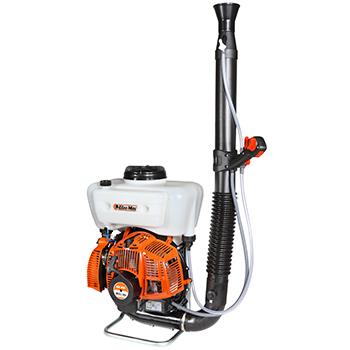
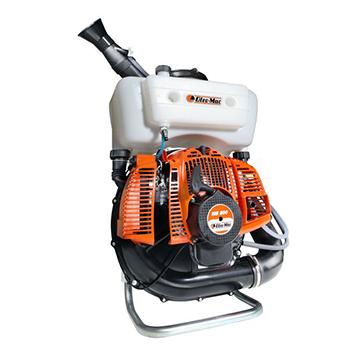
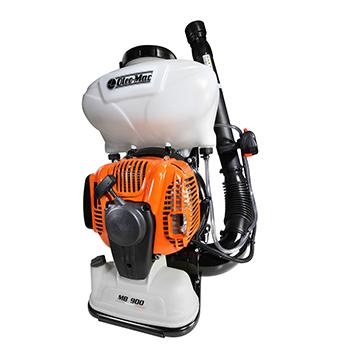
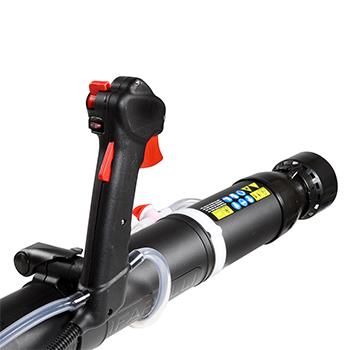
How to distribute treatments using a backpack mistblower
To get good results, when treating plants with a pesticide or other protective product, ensure that the product is distributed evenly on the plants and that any waste is minimal. Here's how to do it in practice:
-
Perform treatment when there is no wind (wind speed below 3-5 m/sec): the wind speed and direction determine the spray drift, i.e. how far the product droplets stray from the treated site.
-
Work when it's not raining or threatening to rain and at the right temperature: in general, treat your plants in the early morning or late afternoon and avoid the hottest hours of the day (otherwise the treatment product may evaporate, instantly neutralising its effectiveness).
-
Adjust the mistblower jet.
-
Point the jet and keep the right distance from the vegetation, so that you only soak the vegetation that requires treatment. Never operate the jet while facing into the wind. With the MB 900 professional backpack mistblower you can reach plants at a distance of 18 m horizontally and 16 m vertically, whereas the MB 800 model enables you to reach 14 and 12 m respectively.
-
Test the mistblower setting by dispensing water only, to verify whether the jet is correctly oriented and whether the distance is exact. At the same time, you can check how much of the treatment penetrates through to the inner foliage of the vegetation.
-
Keep the mistblower well maintained and check that everything works perfectly whenever you use it. Along with proper adjustment, maintenance is essential for the correct application of treatments and to ensure that the products are safe for you and sustainable for the environment.
On the subject of pest control and pesticides: insects, mites, mushrooms and larvae are extremely abundant and it's a constant battle to eradicate them. In our article on how to recognize and eradicate plant pests we describe the 10 most common parasites and how to eliminate them.
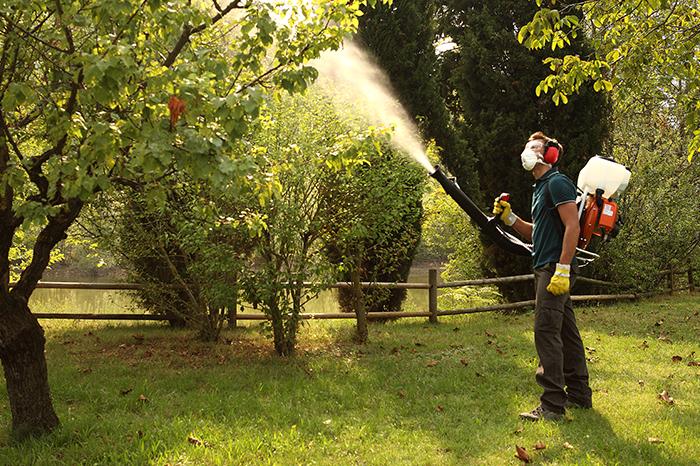
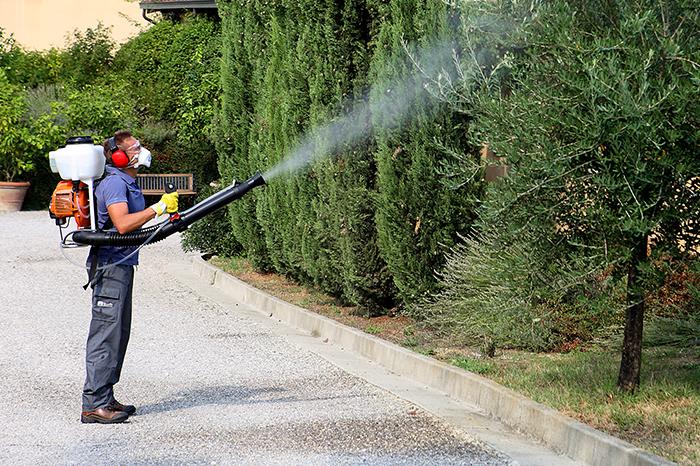
How to work safely with a backpack mistblower
A mistblower is a fast-acting and effective tool for green maintenance and is indispensable in certain situations, as mentioned above. However, it must be used with care to ensure total safety at all times when working:
-
Operate the mistblower away from electrical equipment and power lines.
-
Stay well away from people and animals.
-
Do not point the jet towards people, animals, cars or buildings, as the mistblower may expel stones or other small objects at distance.
-
While working, always adopt a stable and secure stance, move carefully when traversing uneven or steep ground and avoid walking backwards.
-
Perform treatment only if there is sufficient visibility and light.
-
Do not leave the mistblower running while unattended.
When using the mistblower, handling chemical product packaging and preparing treatment mixtures, always wear adequate personal protective equipment (PPE) to protect yourself from poisoning: a one-piece coverall made of strong material, waterproof boots with non-slip soles, strong waterproof gloves, protective goggles, ear defenders or ear plugs and a safety mask.
For the same reason, do not overfill the liquid tank of your mistblower, and make sure the cap is tightly closed. Besides preventing product leakage, you can also limit the weight on your shoulders, which should not exceed 25 kg for men and 20 kg for women (calculate the total weight of the mistblower, treatment and fuel).
Depending on whether you have the appropriate licence or not, you can use the mistblower to dispense plant protection products for professional or non-professional use. However, fungicides, pesticides, herbicides and other products used on plants must be used with the utmost caution, following the manufacturer’s instructions to the letter. Do not exceed the recommended dosage: higher concentrations are toxic to vegetation, whereas lower concentrations will be ineffective.
Would you like to know more? Before starting work, check out this video that summarises how to use a mistblower properly.

